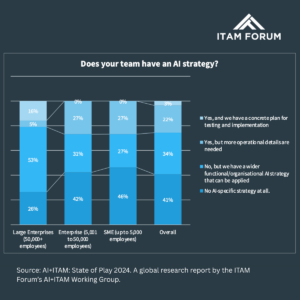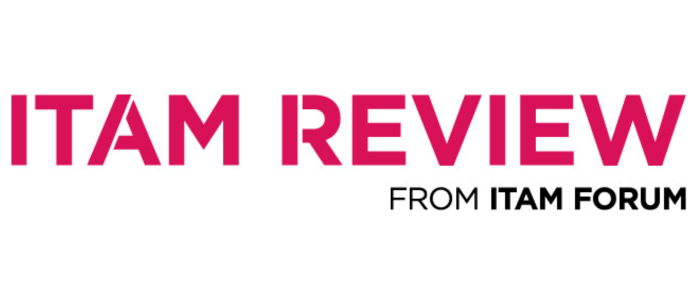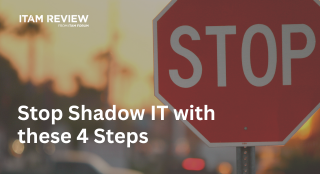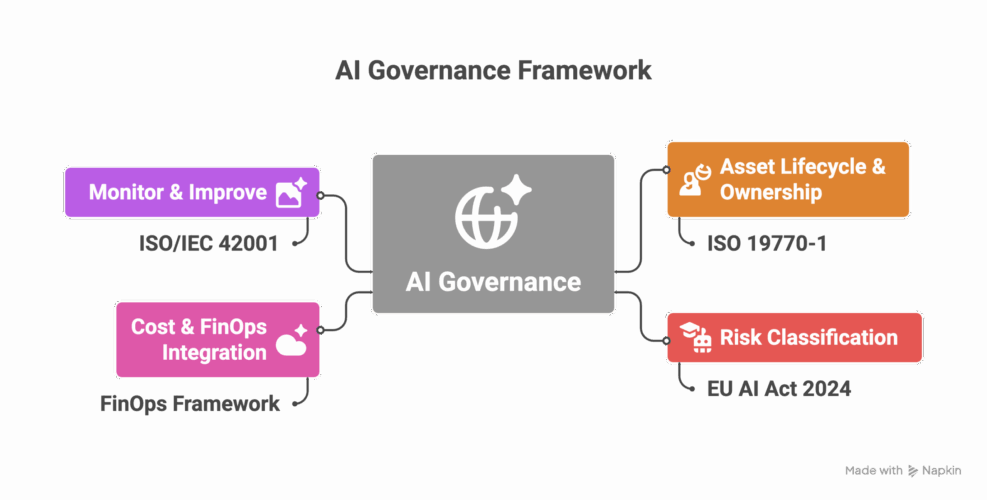AI and ITAM: State of Play 2024 Research Report
In 2024, the ITAM Forum and General Interfaces conducted a global survey (On behalf of the ITAM Forum’s AI+ITAM Working Group) targeting ITAM practitioners, executives, and stakeholders to explore the growing influence of AI on the ITAM industry. With more than 80 responses from 22 countries, the survey revealed key insights into the adoption, challenges, and the future outlook of AI in ITAM.
Key findings include:
- Accelerated AI Adoption: Small and medium enterprises (SMEs) have spearheaded the adoption of generative AI (GenAI), significantly advancing AI integration into businesses during 2024.
- Strategic Uncertainty: Despite the rapid pace of AI innovation, many organisations lack clarity on long-term AI strategies. The top challenges hindering broader AI integration include: insufficient trust in AI systems, a shortage of skilled personnel, and high costs.
- Limited Cost Governance: AI cost management is a blind spot for many organisations. Few have established AI-specific procurement policies or governance frameworks. Alarmingly, more than one-third of respondents admitted to not knowing who within their organisation is responsible for managing AI costs.
- Positive Feedback from Early Adopters: While uncertainty about AI’s broader impact on the ITAM industry persists, initial experiences among early adopters indicate generally positive outcomes.
- Industry Transformation: Respondents widely believe AI adoption will reshape the ITAM workforce, automating entry-level roles and facilitating in-sourcing of ITAM functions. These changes are anticipated to enhance the overall efficiency and effectiveness of the industry.
The survey underscores a dual reality: while AI adoption in ITAM is advancing at an unprecedented pace, a significant gap remains in strategic planning and governance. For the ITAM industry to fully capitalise on AI’s potential, organisations must address challenges related to trust, skills, and cost governance.
- Only 3% of respondents have a defined AI strategy and implementation plan.
- 41% lack an AI strategy entirely.
- 33% of respondents admitted to not knowing who within their organisation is responsible for managing AI costs.

Early signs of AI’s impact—streamlined operations, increased in-sourcing, and improved efficiency—are promising. Moving forward, proactive investment in AI-specific strategies and governance will be crucial to unlocking sustainable, long-term value for the ITAM industry.
- 70%believe AI will enhance the quality of ITAM processes.
- 56% believe it will improve the efficiency of ITAM processes.
- 68% of respondents have not received any formal or on-the-job AI training
The findings presented in this report paint a compelling picture of AI’s transformative potential within the ITAM industry. While adoption is gaining momentum, driven by generative AI and early adopters, the journey toward widespread integration is still in its infancy. Key challenges such as strategic uncertainty, trust, skill shortages, and cost governance underscore the need for proactive efforts by organisations to address these barriers.
Key Takeaways
- Manage AI Like an IT Asset: Treat AI with the same rigour you apply to managing other IT assets. This includes discovery, classification, ownership, and cost control.
- Balance Governance with Innovation: AI governance doesn’t need to stifle innovation. In fact, proper governance can enable faster, safer experimentation by providing clear boundaries within which teams can innovate.
- Collaborate Across Teams: AI governance is a team sport. ITAM, InfoSec, finance, legal, and senior leadership all have a role to play in ensuring AI is used responsibly and strategically.
- Prepare for Compliance and Ethics: Don’t wait for regulations like the EU AI Act to hit you. Be proactive in building ethical and compliant AI systems from day one, turning potential regulatory burdens into innovation enablers.
Next Steps for Organisations
- Establish an AI Governance Team: Form a cross-functional team responsible for overseeing AI initiatives. This group should ensure AI innovation is aligned with business objectives while managing risks.
- Up-skill Your Workforce: AI expertise is in short supply. Invest in training and education so your teams understand the technology and the risks, positioning them to manage AI effectively.
- Start Your Regulatory Compliance Journey: Begin auditing your AI systems and mapping out their compliance with regulations like the EU AI Act. This will ensure you stay ahead of global regulatory trends.
- Monitor and Report AI’s Impact: Use ITAM data to provide real-time insights into how AI is affecting your business, from costs to operational efficiency. This will enable senior leadership to make smarter decisions and avoid potential pitfalls, using real life return-on-investment metrics to support future investment.

Conclusion
AI’s impact on ITAM is multifaceted, offering opportunities to enhance efficiency, quality, and effectiveness while reshaping workforce dynamics by automating repetitive tasks and enabling in-sourcing of critical processes. However, this transformation also highlights the pressing need for clear governance frameworks, robust cost management strategies, and workforce upskilling to build trust and maximise AI’s benefits.
As we look to the future, the ITAM industry must prioritise investment in AI-specific strategies, foster collaboration across stakeholders, and ensure equitable access to resources and expertise. By doing so, the industry can harness AI’s full potential to drive innovation, streamline operations, and elevate its overall impact.
If you’re an ITAM Forum member, you can access the full report via the Members Portal. The report is authored by Eric Chiu and Martin Thompson.
Can’t find what you’re looking for?
More from ITAM News & Analysis
-
Stop Shadow IT Before It Hurts Your Business
Shadow IT often spreads quietly and quickly becomes a serious risk. Just look at the UK-based supermarket chain Co-op. A little-known remote maintenance tool used by an external IT provider was compromised. The result? Nearly 800 ... -
Why ITAM Forum Should Join the Linux Foundation: My Rationale and Your Questions Answered
TLDR. ITAM Forum has the opportunity to join the Linux Foundation as a stand-alone, self-funded project. This article covers a) What’s happening b) Why I think it’s a great move for the ITAM Forum and c) ... -
Microsoft Pricing Changes: EA Customers Face Price Increases
From 1st November 2025, Microsoft will remove all tiered pricing for Online Services under the Enterprise Agreement. This means all customers renewing or purchasing new Online Services after this date, will receive standard level A pricing ...
Software Licensing Training
Similar Posts
-
Eight steps towards AI governance
I delivered our “Managing AI as an Asset” training course the day before the Wisdom conference last week. Thank you to those who attended and provided feedback. It will be available on the LISA platform before ... -
Stop Shadow IT Before It Hurts Your Business
Shadow IT often spreads quietly and quickly becomes a serious risk. Just look at the UK-based supermarket chain Co-op. A little-known remote maintenance tool used by an external IT provider was compromised. The result? Nearly 800 ... -
AI Governance Through an ITAM Lens: Treat AI as a Status Change, Not a New Asset
Managing AI in the enterprise is a team sport. In this article, I want to explore specifically what ITAM brings to the table as we enter the AI era. As I’ve mentioned in previous articles on ... -
Why ITAM Forum Should Join the Linux Foundation: My Rationale and Your Questions Answered
TLDR. ITAM Forum has the opportunity to join the Linux Foundation as a stand-alone, self-funded project. This article covers a) What’s happening b) Why I think it’s a great move for the ITAM Forum and c) ...




